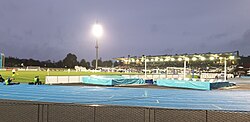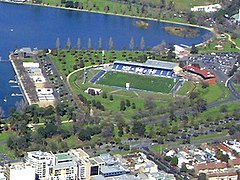Lakeside Stadium
 | |
 | |
| Former names | Lake Oval, South Melbourne Cricket Ground, Bob Jane Stadium |
|---|---|
| Location | Aughtie Drive, Albert Park, Victoria |
| Coordinates | 37°50′25″S 144°57′54″E / 37.84028°S 144.96500°E |
| Operator | State Sports Centre Trust |
| Capacity | 12,000 (7,400 seated)[1] |
| Surface | Grass (soccer stadium), blue synthetic (athletics track) |
| Construction | |
| Broke ground | 1876 |
| Opened | 1878 |
| Renovated | 1995, 2011, 2019 |
| Tenants | |
| Athletics
Australian Little Athletics Soccer South Melbourne FC Melbourne Victory FC (Women's Team)
other tenants Albert-park Football Club (Challenge Cup/VFA, 1878-1879) South Melbourne Football Club (VFA/VFL, 1879–1915, 1917-1941, 1947-1981) Victorian Institute of Sport South Melbourne Cricket Club (until 1994)
Methodist Ladies' College | |
| Ground information | |
| International information | |
| Only WODI | 31 January 1985: |
| As of 8 September 2020 Source: CricketArchive | |
Lakeside Stadium is an Australian sports arena in the
The venue was built on the site of a former
It is one of four sporting facilities in Melbourne organised under the banner of publicly funded organisation Melbourne Sports Centres - the others being the
History
Cricket
The
Australian rules football

The South Melbourne Football Club was formed in 1874.[4][6]
With the formation of Albert Park from a low lying swamp, a growing population and the popularity of football in the 1870s, an oval was established at the South Melbourne end of the park by the late 1870s, and both clubs soon adopted it as their home ground.
What came to be known as the Lake Oval or Lakeside Oval served most prominently as the home ground for
In 1887 an elaborate new grandstand was constructed, it opened in time to host Tasmania vs Essendon match which held a capacity crowd of 10,000 spectators.[7]
In its early days, the ground was considered one of the best in the league and was the venue for the
Following the destruction of the previous grandstand by fire, a new grandstand was built in 1926 designed by Clegg & Morrow and featuring a non-symmetrical layout, ornamental gables and prominent vents in the form of ridge lanterns.[9][4]
When electric floodlighting was installed at the venue during the 1950s, it became one of the first venues in Melbourne to regularly host night football matches, including the
The ground record crowd for Lake Oval was set on 30 July 1932, when 41,000 turned out to see Carlton defeat South Melbourne by nine points.[13]


South Melbourne used the ground for home games until the end of the
The ground hosted 892 senior matches in the recognized top level of Victorian football - 188 in the VFA and 704 in the VFL/AFL - in 98 seasons of competition, with another 26 matches - 24 in the unaffiliated era and two in the VFA - being played on the site in the eight seasons prior to the ground's construction.
The Lake Oval was used for VFL/AFL reserves matches after South Melbourne's relocation in 1981 until 1993.[4]

For a time during the late 1980s and early 1990s, the struggling Fitzroy Football Club used the ground as a training and administrative base.[16][17] The Old Xaverians Football Club of the Victorian Amateur Football Association were based there in 1993 and 1994.[4]
Redevelopment and transformation into a soccer stadium
Redevelopment of the venue from an oval football/cricket stadium to the rectangular soccer stadium which became known as the Lakeside Stadium took place in 1995, when South Melbourne FC was forced out of its old home at Middle Park.[18] The stadium was built with a capacity of 14,000 people,[4] which was achieved or approached several times in South Melbourne's history at the ground. A grandstand with an approximate capacity of 3,000 people was situated on one side, with a social club, reception centre and administrative facilities built in, while the other three sides of the ground consisted of open terraces with wooden seats. At one stage, a second two tiered stand for the outer side was proposed, but only preliminary plans were produced.[19][4]
As well as being the home of South Melbourne FC, the venue also hosted games by the
The old grandstand remained unused and decaying in this period; at one stage the Sydney Swans football club showed interest in repurchasing it to be used as a museum and administrative building, while there were also calls from others to demolish the building because of its derelict state.
Athletics venue
In May 2008, the state government announced that Lakeside Stadium would undergo a major redevelopment, in order to accommodate an athletics track, as part of moving Athletics Victoria from
The synthetic 8-lane athletics track was constructed to international
Despite often providing windy conditions for athletes, some world class performances have been recorded at the venue, including a 12.49 second run by Sally Pearson over the 100m hurdles.[25]
The venue is operated by the State Sports Centre Trust, the operators of the
See also
- List of Australian rules football statues, a list of Australian rules football-related statues across Australia
References
- ^ "Lakeside Stadium". South Melbourne FC. Retrieved 5 July 2017.
- ^ South Melbourne did not compete in 1916 due to World War I, while the ground was occupied by the military from 1942 to 1946.
- ^ Syson, Ian (30 September 2013). "Victorian Soccer Fixtures and Results 1883". Neos Osmos. Retrieved 24 June 2016.
- ^ a b c d e f g h i j k l "Lakeside Stadium". Retrieved 9 April 2022.
- ^ "Melbourne Sports Centres - Home". melbournesportscentres.com.au. Retrieved 1 April 2020.
- ^ "Timeline: VFA era and the birth of a new club (1874 - 1897)". Retrieved 21 April 2022.
- ^ "TASMANIA V. ESSENDON". The Mercury. Vol. L, no. 5, 380. Tasmania, Australia. 28 May 1887. p. 4. Retrieved 26 October 2022 – via National Library of Australia.
- ^ "Timeline: VFA era and the birth of a new club (1874 - 1897)". Retrieved 21 April 2022.
- ^ "South Melbourne Cricket & Football Grandstand and Press Box". vhd.heritagecouncil.vic.gov.au. Retrieved 1 April 2020.
- ^ "Lone V.F.A. club's 'no' to night football". The Sun News-Pictorial. Melbourne. 2 April 1957. p. 47.
- ^ Carrick, Noel (24 July 1957). "Burst by S.A. crushes V.F.A.". The Sun News-Pictorial. Melbourne. p. 45.
- ^ Bretland, Bernie (3 July 1958). "Big men pave way for WA". The Sun News-Pictorial. Melbourne. p. 38.
- ^ "Lake Oval - Attendances (1921-1981)". AFL Tables. Retrieved 5 July 2017.
- ^ "Timeline: Tough times see the Swans fly north (1960 - 1984)". Retrieved 21 April 2022.
- ^ "Timeline: Tough times see the Swans fly north (1960 - 1984)". Retrieved 9 April 2022.
- ^ Linnell, Stephen (23 July 1993). "Lion members back move to Western Oval". The Age. Melbourne. p. 28. Retrieved 5 July 2017.
- ^ "The moment that began Fitzroy's long, slow death". 24 June 2016. Retrieved 21 April 2022.
- ^ Keyte, Jennifer (presenter); Donahoe, Brendan (reporter) (29 May 1994). "Albert Park - The Track". Seven Nightly News. Seven Network. HSV Melbourne. Retrieved 5 July 2017 – via Argiri on YouTube.
- better source needed]
- ^ Esamie, Thomas; Stock, Greg; Cazal, Jean-Michel; Scicluna, Frank. "Socceroo Internationals for 1996". OzFootball. Retrieved 5 July 2017.
- ^ Esamie, Thomas. "Matildas Internationals for 2006". OzFootball. Retrieved 5 July 2017.
- ^ Punshon, John. "2006 Vodafone Cup Results". OzFootball. Retrieved 5 July 2017.
- ^ "State Sports Facilities Project". Major Projects Victoria. Archived from the original on 22 April 2011. Retrieved 5 July 2017.
- ^ "State Sports Facilities Project Profile" (PDF). Melbourne Sports and Aquatic Centre.
- ^ "Lakeside Stadium Track Records on the Athletics Track Directory". Inside Athletics.
External links
- Official website
- Lakeside Stadium at Austadiums
- "Around the Grounds", online documentary on Lakeside Oval
